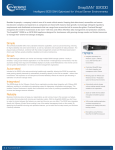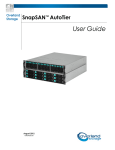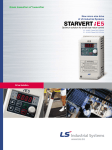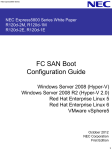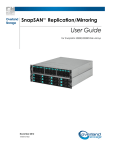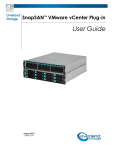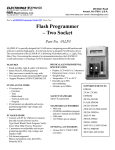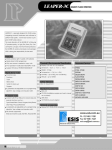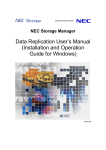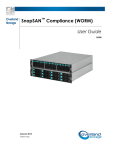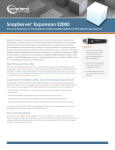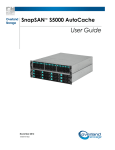Download SnapSAN VSS Provider User Guide
Transcript
Overland Storage SnapSAN™ VSS Provider User Guide S3000/S5000 March 2013 10400401-002 SnapSAN S3000/S5000 VSS Provider User Guide ©2012-13 Overland Storage, Inc. All rights reserved. Overland®, Overland Data®, Overland Storage®, ARCvault®, DynamicRAID®, GuardianOS® (EU), LibraryPro®, LoaderXpress®, Multi-SitePAC®, NEO®, NEO Series®, PowerLoader®, Protection OS®, REO®, REO 4000®, REO Series®, Snap Appliance®, Snap Care® (EU), SnapSAN®, SnapServer®, StorAssure®, Ultamus®, VR2®, and XchangeNOW® are registered trademarks of Overland Storage, Inc. GuardianOS™, RAINcloud™, RapidRebuild™, SnapDisk™, SnapEDR™, Snap Enterprise Data Replicator™, SnapExpansion™, SnapScale™, SnapScale X2™, SnapServer DX Series™, SnapServer Manager™, and SnapWrite™ are trademarks of Overland Storage, Inc. All other brand names or trademarks are the property of their respective owners. The names of companies and individuals used in examples are fictitious and intended to illustrate the use of the software. Any resemblance to actual companies or individuals, whether past or present, is coincidental. PROPRIETARY NOTICE All information contained in or disclosed by this document is considered proprietary by Overland Storage. By accepting this material the recipient agrees that this material and the information contained therein are held in confidence and in trust and will not be used, reproduced in whole or in part, nor its contents revealed to others, except to meet the purpose for which it was delivered. It is understood that no right is conveyed to reproduce or have reproduced any item herein disclosed without express permission from Overland Storage. Overland Storage provides this manual as is, without warranty of any kind, either expressed or implied, including, but not limited to, the implied warranties of merchantability and fitness for a particular purpose. Overland Storage may make improvements or changes in the product(s) or programs described in this manual at any time. These changes will be incorporated in new editions of this publication. Overland Storage assumes no responsibility for the accuracy, completeness, sufficiency, or usefulness of this manual, nor for any problem that might arise from the use of the information in this manual. FM 2.1.1 or 2.2 [reviewers ignore..] Overland Storage, Inc. 9112 Spectrum Center Blvd. San Diego, CA 92123 U.S.A. Tel: 1.877.654.3429 (toll-free U.S.) Tel: +1.858.571.5555 Option 5 (International) Fax: +1.858.571.0982 (general) Fax: +1.858.571.3664 (sales) www.overlandstorage.com 10400401-002 03/2013 ©2012-13 Overland Storage, Inc. ii Preface This user guide explains how to install, setup, and use the SnapSAN VSS Provider software.VSS Provider is software that facilitates business backup operations by linking the Volume Shadow Copy Service (VSS) of Microsoft® Windows Server® 2003 or Microsoft® Windows Server® 2008 with data replication (VSS Storage Volume Cloning or VSS Provider Replication and Mirroring) and a snapshot function (VSS Provider Snapshots). This guide assumes that you are familiar with computer hardware, data storage, and network administration terminology and tasks. It also assumes you have basic knowledge of Internet SCSI (iSCSI), Serial-attached SCSI (SAS), Serial ATA (SATA), Storage Area Network (SAN), and Redundant Array of Independent Disks (RAID) technology. This guide is intended for those who have basic knowledge of backup and recovery using Microsoft Windows Exchange Server 2003 or Microsoft Windows Server 2008 and the VSS Provider snapshot function or data replication function. This manual explains functions implemented by the following program products: • VSS Provider Manager and VSS Provider base product • VSS Provider Control Command This manual is applicable to the program products of the following versions: • VSS Provider Manager Ver4.2 or later • VSS Provider Base Product Ver4.2 or later • VSS Provider Control Command Ver4.2 or later The VSS Provider series disk array subsystems is referred to as a disk array in this manual unless clearly specified. Product Documentation and Firmware Updates Overland Storage SnapSAN product documentation and additional literature are available online, along with the latest release of the SnapSAN 3000/5000 software. Point your browser to: http://docs.overlandstorage.com/snapsan Follow the appropriate link to download the latest software file or document. For additional assistance, search at http://support.overlandstorage.com. 10400401-002 03/2013 ©2012-13 Overland Storage, Inc. i-i SnapSAN S3000/S5000 VSS Provider User Guide Overland Technical Support For help configuring and using your SnapSAN 3000/5000, search for help at: http://support.overlandstorage.com/kb You can email our technical support staff at [email protected] or get additional technical support information on the Contact Us web page: http://www.overlandstorage.com/company/contact-us/ For a complete list of support times depending on the type of coverage, visit our web site at: http://support.overlandstorage.com/support/overland_care.html Conventions This document exercises several alerts and typographical conventions. Alerts Convention Description & Usage IMPORTANT An Important note is a type of note that provides information essential to the completion of a task or that can impact the product and its function. CAUTION A Caution contains information that the user needs to know to avoid damaging or permanently deleting data or causing physical damage to the hardware or system. WARNING A Warning contains information concerning personal safety. Failure to follow directions in the warning could result in bodily harm or death. Typographical Conventions Convention Description & Usage Button_name Words in this special boldface font indicate command buttons found in the Web Management Interface. Ctrl-Alt-r This type of format details the keys you press simultaneously. In this example, hold down the Ctrl and Alt keys and press the r key. NOTE A Note indicates neutral or positive information that emphasizes or supplements important points of the main text. A note supplies information that may apply only in special cases, for example, memory limitations or details that apply to specific program versions. Menu Flow Indicator (>) Words with a greater than sign between them indicate the flow of actions to accomplish a task. For example, Setup > Passwords > User indicates that you should press the Setup button, then the Passwords button, and finally the User button to accomplish a task. Courier Italic A variable for which you must substitute a value Courier Bold Commands you enter in a command-line interface (CLI) Information contained in this guide has been reviewed for accuracy, but not for product warranty because of the various environments, operating systems, or settings involved. Information and specifications may change without notice. 10400401-002 03/2013 ©2012-13 Overland Storage, Inc. i-ii SnapSAN S3000/S5000 VSS Provider User Guide Electrostatic Discharge Information A discharge of static electricity can damage static-sensitive devices. Proper packaging and grounding techniques are necessary precautions to prevent damage. To prevent electrostatic damage, observe the following precautions: 10400401-002 03/2013 • Transport products in static-safe containers such as conductive tubes, bags, or boxes. • Cover the appliance with approved static-dissipating material. • Use a wrist strap connected to the work surface and properly-grounded tools and equipment. • Keep the work area free of non-conductive materials such as foam packing materials. • Make sure you are always properly grounded when touching a static-sensitive component or assembly. • Avoid touching pins, leads, or circuitry. ©2012-13 Overland Storage, Inc. i-iii SnapSAN S3000/S5000 VSS Provider User Guide Contents Preface Chapter 1 - VSS Provider Overview ............................................................................................................................................................... 1-1 Backup ............................................................................................................................................................. 1-1 Providers ........................................................................................................................................................... 1-2 Software Required ................................................................................................................................................ 1-2 Volume Types .................................................................................................................................................. 1-2 Requestors ....................................................................................................................................................... 1-2 Writers ............................................................................................................................................................... 1-2 Chapter 2 - VSS Provider Installation Install ...................................................................................................................................................................... 2-3 Uninstall .................................................................................................................................................................. 2-5 Chapter 3 - System Configuration Hardware Configuration ...................................................................................................................................... 3-1 Software Configuration ....................................................................................................................................... 3-2 Hardware Required ........................................................................................................................................ 3-2 Servers/Software ............................................................................................................................................. 3-2 Snapshot or Data Replication ............................................................................................................................. 3-3 Snapshot Installation ....................................................................................................................................... 3-3 Data Replication Installation ......................................................................................................................... 3-3 Volume Types ........................................................................................................................................................ 3-3 Initial Setup of Volumes .................................................................................................................................. 3-4 Backup Server Connected to Data Replication Volume (RV) ....................................................................... 3-4 Backup and Restore ....................................................................................................................................... 3-5 Chapter 4 - Error Management Actions When Error Occurs .................................................................................................................................. 4-1 Backup Errors .................................................................................................................................................. 4-1 VSS Provider Restarted ................................................................................................................................... 4-1 Volume to Initial State .................................................................................................................................... 4-1 Backup Server ....................................................................................................................................................... 4-2 Backup Server Connected to Snapshot LV ................................................................................................. 4-2 Backup Server Connected to Data Replication RV ................................................................................... 4-2 Collecting Information of Unclear Failure .................................................................................................... 4-3 Chapter 5 - Troubleshooting Event Log Warning Message ......................................................................................................................... 5-1 Event Log Error Message ................................................................................................................................ 5-1 10400401-002 03/2013 ©2012-13 Overland Storage, Inc. i SnapSAN S3000/S5000 VSS Provider User Guide Appendix A - Error Failure Messages Appendix B - Command Lists Index 10400401-002 03/2013 ©2012-13 Overland Storage, Inc. ii VSS Provider Chapter 1 Overview This chapter provides an overview of the Volume Shadow Copy Service (VSS) Provider and explains system configuration and other fundamentals.VSS Provider was implemented in Microsoft Windows Exchange Server 2003 and Microsoft Windows Server 2008, as a new function for performing storage management. Backup Backup using VSS Provider is performed by taking a request from the requestor as a trigger. When VSS Provider receives a backup request from the requestor, it performs coordinating operations with the writers and provider, and it instructs the provider to create a replication. The SnapSAN S3000/S5000 operations is performed entirely under the control of VSS Provider. Accordingly, a user can easily carry out non-interrupted backup without becoming involved with complicated scripts for each application, by executing the requestor. Figure 1-1: VSS Provider Basic Configuration 10400401-002 03/2013 ©2012-13 Overland Storage, Inc. 1-1 SnapSAN S3000/S5000 VSS Provider User Guide Providers A hardware provider is software exclusively for the in-house manufactured disk arrays (supplied by the storage vendor), makes it possible to create shadow copies using hardwarespecific replication functions. VSS Provider is a hardware provider. A software provider is software that a software vendor supplies for creating shadow copies. The system provider that is supplied by Microsoft Corporation is also a software provider. Software Required The following software is needed on each server or disk array: Application Server • Job management software (Example: JobCenter) • Requestor (Example: Protection Manager) • Exchange Server 2003, Exchange Server 2007 or Exchange Server 2010 • VSS Provider • Control Command Backup Server • Job management software (Example: JobCenter) • Requestor (Example: Protection Manager) • Backup software (Example: NetBackup) • VSS Provider • Control Command Management Server • SnapSAN Manager Disk Array • Snapshots, Volume Cloning, or Replication and Mirroring • Access Control Volume Types VSS Provider handles volumes that are subject to snapshot or replication operations by a disk array’s logical disk. Requestors VSS Provider supports Protection Manager and other software as requestors. Writers VSS Provider supports the following as a writer: 10400401-002 03/2013 • Microsoft Exchange Server 2003 • Microsoft Exchange Server 2007 ©2012-13 Overland Storage, Inc. 1-2 SnapSAN S3000/S5000 VSS Provider User Guide 10400401-002 03/2013 • Microsoft Exchange Server 2010 • File system (NTFS) ©2012-13 Overland Storage, Inc. 1-3 VSS Provider Installation Chapter 2 This chapter provides a description of the basic requirements for installing VSS Provider. Operating Environments for Windows Exchange Server 2003. 10400401-002 03/2013 Item Description OS Windows Exchange Server 2003, Standard Edition (SP1,SP2) Windows Exchange Server 2003, Enterprise Edition (SP1,SP2) Windows Storage Exchange Server 2003, Standard Edition (SP1,SP2) Windows Storage Exchange Server 2003, Enterprise Edition (SP1,SP2) Windows Exchange Server 2003 R2, Standard Edition Windows Exchange Server 2003 R2, Enterprise Edition Windows Exchange Server 2003 R2, Standard Edition (SP2) Windows Exchange Server 2003 R2, Enterprise Edition (SP2) Windows Storage Exchange Server 2003 R2, Standard Edition (SP2) Windows Storage Exchange Server 2003 R2, Enterprise Edition (SP2) Windows Exchange Server 2003, Standard x64 Edition (SP1,SP2) Windows Exchange Server 2003, Enterprise x64 Edition (SP1,SP2) Windows Exchange Server 2003 R2, Standard x64 Edition Windows Exchange Server 2003 R2, Enterprise x64 Edition Windows Exchange Server 2003 R2, Standard x64 Edition (SP2) Windows Exchange Server 2003 R2, Enterprise x64 Edition (SP2) Software • BaseProduct (including Storage Manager) • Volume Cloning Ver 2 or later • Remote Replication Ver 2 or later, • DynamicSnapVolume or DynamicSnapVolume Ver 3 • AccessControl • PathManager • ControlCommand on Windows • Protection Manager • Microsoft® Exchange Server 2003 Standard Edition (SP1,SP2) • Microsoft® Exchange Server 2003 Enterprise Edition (SP1,SP2) • Microsoft® Exchange Server 2007 Standard Edition (Non SP,SP1,SP2,SP3) • Microsoft® Exchange Server 2007 Enterprise Edition (Non SP,SP1,SP2,SP3) Memory Minimum required memory for an application server: Memory required by the OS + 6.0 MB Minimum required memory for a backup server: Memory required by the OS + 30.0 MB Disk space 1.2 MB or more ©2012-13 Overland Storage, Inc. 2-1 SnapSAN S3000/S5000 VSS Provider User Guide Operating Environment for Windows Server 2008. 10400401-002 03/2013 Item Description OS Windows Server 2008, Standard (x86) Windows Server 2008, Enterprise (x86) Windows Server 2008, Standard (x64) Windows Server 2008, Enterprise (x64) Windows Server 2008, Standard (x86) (SP2) Windows Server 2008, Enterprise (x86) (SP2) Windows Server 2008, Standard (x64) (SP2) Windows Server 2008, Enterprise (x64) (SP2) Windows Storage Server 2008, Standard (x64) Windows Storage Server 2008, Enterprise (x64) Windows Storage Server 2008, Standard (x64) (SP2) Windows Storage Server 2008, Enterprise (x64) (SP2) Windows Server 2008 R2, Standard Windows Server 2008 R2, Enterprise Windows Server 2008 R2, Datacenter Windows Server 2008 R2, Standard (SP1) Windows Server 2008 R2, Enterprise (SP1) Windows Server 2008 R2, Datacenter (SP1) Software • BaseProduct (including Storage Manager) • Volume Cloning Ver 2 or later • Remote Replication Ver 2 or later • DynamicSnapVolume • DynamicSnapVolume Ver 3 • AccessControl • PathManager • ControlCommand on Windows • Protection Manager • Microsoft® Exchange Server 2007 Standard Edition (SP1,SP2,SP3) • Microsoft® Exchange Server 2007 Enterprise Edition (SP1,SP2,SP3) • Microsoft® Exchange Server 2010 Standard Edition (Non SP,SP1,SP2) • Microsoft® Exchange Server 2010 Enterprise Edition (Non SP SP1,SP2) Memory Minimum required memory for an application server: Memory required by the OS + 6.0 MB Minimum required memory for a backup server: Memory required by the OS + 30.0 MB Disk space 1.2 MB or more ©2012-13 Overland Storage, Inc. 2-2 SnapSAN S3000/S5000 VSS Provider User Guide Install To install VSS Provider, perform the procedure below. When installing, make sure: • You are logged in with Administrator privileges. • No programs are running. • ControlCommand has been installed. 1. Insert the installation CD storing the VSS Provider installer into the CD-ROM drive. For this procedure, the "X:" drive is assumed to be assigned to the CD-ROM drive. 2. From the Windows Start menu, select Run. The Run dialog box appears. 3. Execute the installation program (SETUP.EXE) appropriate for your OS architecture. Installation program for Windows Exchange Server 2003 x86 architecture or Windows Server 2008 x86 architecture: X:\VSS\SETUP\SETUP.EXE Installation program for Windows Exchange Server 2003 x64 architecture or Windows Server 2008 x64 architecture: X:\VSS\SETUP64\SETUP.EXE 4. Perform installation by following the installer instructions. The following software is installed. For Windows Exchange Server 2003 x86 architecture or Windows Server 2008 x86 architecture: • VSS Provider For Windows Exchange Server 2003 x64 architecture or Windows Server 2008 x64 architecture: • VSS Provider (x64) If PathManager is installed on the backup server, perform the following procedure on that server: For Windows Exchange Server 2003: 1. Select Start, All Programs, Accessories, System Tools, and then Scheduled Tasks. Execute the program in the Scheduled Tasks folder that is indicated below. Add a scheduled task. 2. Use the Scheduled Task wizard to register the program. Click Next. 10400401-002 03/2013 ©2012-13 Overland Storage, Inc. 2-3 SnapSAN S3000/S5000 VSS Provider User Guide 3. Select the program to execute. Click Browse, and then select one of the following programs in the file selection dialog box that appears: installation-folder#\iSMrpl\sbin\iSMvss_clear.exe # The default installation-folder: For Windows Exchange Server 2003 x86 architecture: C:\Program Files\Overland For Windows Exchange Server 2003 x64 architecture: C:\Program Files (x86)\Overland. 4. Under Perform this task, specify when to perform the task. Select When my computer starts, and then click Next. 5. Specify the user name and password to use when executing commands. Specify the user name and password of a user who has Administrator privileges, and then click Next. 6. Click Finish, and then make sure that the following task has been registered: iSMvss_clear For Windows Server 2008: 1. Select Start, All Programs, Accessories, System Tools, and then Task Scheduler. In the Actions pane, click Create Task. 2. On the General tab of the Create Task dialog box, specify the following settings: • Name: iSMvss_clear • Security options: select Run whether user is logged on or not • Security options: select Run with highest privileges 3. On the Triggers tab of the Create Task dialog box, specify the following settings: • Click New to display the New Trigger dialog box. • In this dialog box, change the value of Begin the task to At startup. • Click OK. 4. On the Actions tab of the Create Task dialog box, specify the following settings: a. Click New to display the New Action dialog box. b. In this dialog box, under Program/script in the Settings area, click Browse, and then select one of the following files in the Open dialog box. installation-folder*\iSMrpl\sbin\iSMvss_clear.exe * The default installation folder: For Windows Server 2008 x86 architecture: C:\Program Files\(x86)\Overland For Windows Server 2008 x64 architecture: C:\Program Files (x86)\Overland c. Click OK. 5. In the Create Task dialog box, click OK. In the Task Scheduler dialog box, the information about the user account to be used to execute this task is requested. Enter the user name and password of a user who has Administrator privileges, and then click OK. In Windows Server 2008, perform the following procedure on the backup server once every day, while a backup is not running. 10400401-002 03/2013 ©2012-13 Overland Storage, Inc. 2-4 SnapSAN S3000/S5000 VSS Provider User Guide 1. Stop the Volume Shadow Copy service. NET STOP "VSS" 2. Stop the Storage VSS Provider service. NET STOP "Storage VSS Provider" • You do not need to start these services.These services start up automatically when the backup is performed. • In Windows Exchange Server 2003, Windows Exchange Server 2003 R2 or Windows Server 2008 R2, you do not need to perform this procedure. Uninstall This section describes the instructions to uninstall VSS Provider. When uninstalling, make sure: • You are logged in with Administrator privileges. • No programs are running. • ControlCommand has been installed. Uninstall VSS Provider or VSS Provider (x64) before uninstalling ControlCommand. Perform the following procedure before uninstalling VSS Provider or VSS Provider (x64): 1. Make sure that VSS Provider services are not running. If these services are running, perform the following operations: 2. Stop the Volume Shadow Copy service. 3. Stop the Storage VSS Provider service. 4. If PathManager is installed on the backup server, remove the following registered task from the task scheduler on that server: iSMvss_clear 5. In the Control Panel, select Add or Remove Programs or Programs and Features, and then uninstall the following software. For Windows Exchange Server 2003 x86 architecture or Windows Server 2008 x86 architecture: • VSS Provider For Windows Exchange Server 2003 x64 architecture or Windows Server 2008 x64 architecture: • VSS Provider (x64) 6. Perform uninstallation by following the installer instructions The following software is uninstalled. For Windows Exchange Server 2003 x86 architecture or Windows Server 2008 x86 architecture: • VSS Provider For Windows Exchange Server 2003 x64 architecture or Windows Server 2008 x64 architecture: • 10400401-002 03/2013 VSS Provider (x64) ©2012-13 Overland Storage, Inc. 2-5 SnapSAN S3000/S5000 VSS Provider User Guide This example shows the system installation procedure by taking a tape backup system in which the SnapSAN S3000/S5000 is used as an example. Figure 2-1: Hardware Configuration Flow 10400401-002 03/2013 ©2012-13 Overland Storage, Inc. 2-6 Chapter 3 System Configuration Hardware Configuration The configuration example shows: hardware components, performance requirements, and disk capacity. Figure 3-1: Hardware Configuration Example To utilize the snapshot or data replication function more efficiently, separate the application servers, which process tasks from the backup servers. Accordingly, the tape backup operation gives no additional load to application servers. Though the application or backup server may also be used as a management server, using a specific management server is recommended. Use of LAN connection is strongly recommended for connection with the disk array. Connect the path of individual servers, to be connected to the disk array, to the port of different directors of the disk array, limiting the servers to be accessed by AccessControl. 10400401-002 03/2013 ©2012-13 Overland Storage, Inc. 3-1 SnapSAN S3000/S5000 VSS Provider User Guide Software Configuration The example shows a software configuration. Select the software to use from the business equipment and operations mode. The software configuration varies according to the requestor selected. Figure 3-2: Software Configuration Example Hardware Required To install and use VSS Provider, the following hardware is needed: Disk Array – This is a disk array in which the snapshot function (Snapshots) or data replication function (Volume Cloning or Replication and Mirroring) is loaded. Application Server – This performs snapshot or data replication operations. Backup Server – This is arranged to perform backup of data from a replication to tape or other media. Magnetic Tape Unit – This is used if tape backup is needed. Use a tape unit that is supported by the backup software. Management Server – This performs a disk array management. It can also serve as the backup server or application server. Servers/Software Install the software into the following servers: 10400401-002 03/2013 ©2012-13 Overland Storage, Inc. 3-2 SnapSAN S3000/S5000 VSS Provider User Guide Application Server • JobCenter • Protection Manager • Exchange Server 2003 • VSS Provider • ControlCommand Backup Server • JobCenter • Protection Manager • NetBackup • VSS Provider • ControlCommand Management Server • SnapSAN Manager Disk Array • Snapshots, Volume Cloning, or Replication and Mirroring • AccessControl Snapshot or Data Replication Snapshot Installation Perform “Installation Procedure” to prepare for backup operations where the snapshot function is used. Data Replication Installation Perform “Installation Procedure” to prepare for backup operations in which the data replication function is used. Requestor Installation Follow instructions for installing a requestor. Volume Types VSS Provider handles volumes that are subject to snapshot or replication operations by a disk array’s logical disk. When there are multiple partitions or link volumes on one logical disk, depending on the operation, it may not be possible to guarantee data consistency if a replication operation is executed for a volume made up of multiple partitions or link volumes or for a dynamic disk volume. The table below shows the function range for each disk. 10400401-002 03/2013 ©2012-13 Overland Storage, Inc. 3-3 SnapSAN S3000/S5000 VSS Provider User Guide Table 3-1: Available Volume Type Disk Type Volume Type Basic disk Primary partition (MBR format) √ Primary partition (GPT format) √ Dynamic disk Availability Link Volume on expanded partition - Simple volume - Spanned volume - Striped volume - Mirror volume - RAID5 volume - √: Recommended configuration -: Operation inhibited Initial Setup of Volumes Backup Server Connected to Snapshot link volume (LV) When performing backup operations in which the snapshot function is used, the initial setup below is necessary. Execute identical operations for target volumes used in backup operations. The volume states, which are the states in which “Installation Procedure” in the “Snapshot User’s Manual (Installation and Operation Guide for Windows) ended, are assumed to be “active” for the SV state and “unlink” for the LV link state. 1. Start a command prompt on the backup server. 2. Confirm that volumes used in backup operations have been registered in the volume list created in (Installation and Operation Guide for Windows)” and re-create the volume list. > iSMvollist -a 3. In order to change the LV access restriction to Not Available (NA), stop the volume beforehand. Here, the setting is made for logical disk name lv001. > iSMvss -devmode disable -vol lv001 -volflg ld 4. Change the LV access restriction to Not Available (NA). Here, settings are made for logical disk names lv001 and sv001. > iSMsc_link -lv lv001 -lvflg ld -sv sv001 -svflg ld -lvacc na > iSMsc_unlink -lv lv001 -lvflg ld The above is the end of environment setup for operation using the snapshot function. Backup Server Connected to Data Replication Volume (RV) When performing backup operations in which the data replication function is used, the initial setup below is necessary. Execute identical operations for target volumes used in backup operations. 10400401-002 03/2013 ©2012-13 Overland Storage, Inc. 3-4 SnapSAN S3000/S5000 VSS Provider User Guide 1. Start a command prompt on the backup server. 2. Confirm that volumes used in backup operations have been registered in the volume list created in “Data Replication Installation”. a. If they are not registered, re-create the volume list. > iSMvollist -a b. If the RV is replicate state, execute Separate to separate the Master Volume (MV) and RV and make the RV available. Here, execute using the settings below. If the RV is separated, the command below need not be executed. • Access restriction for RV after separated: rw (Read/Write) (Default value) • Specify wait for separation to complete > iSMrc_separate-mv mv001-mvflg ld–rv rv001–rvflg ld-wait 3. In order to change the RV access restriction to Not Available (NA), stop the volume beforehand. Here, the setting is made for logical disk name rv001. > iSMvss -devmode disable -vol rv001 -volflg ld 4. Change the RV data state to invalid and the RV access restriction to Not Available (NA). Here, the setting is made for logical disk name rv001. > iSMrc_rvmode -rv rv001 -rvflg ld -rvdata invalid -rvacc na -force The above is the end of environment setup for operation using the data replication function. Backup and Restore Follow backup and restore operations. 10400401-002 03/2013 ©2012-13 Overland Storage, Inc. 3-5 Error Management Chapter 4 Actions When Error Occurs This chapter explains how to address errors that occur during backup when VSS Provider is used. Backup Errors When an error has occurred during backup, investigate the cause of the error using the procedure below and re-execute the backup after eliminating the cause of the error. 1. Verify if the error was output in the application’s event log. 2. If you were able to confirm the error number and error message, check Appendix A “Error Messages at Time of Failure”. 3. Refer to the explanation in (Measure) and eliminate the cause of the error. If there are unformatted partitions, a warning may be output to the (application) event log when executing VSS Provider backup. This does not affect backup processing. For details, refer to “Event Log Warning Message”. VSS Provider Restarted When the VSS Provider must be restarted, follow the instructions: 1. From the Windows (Start) button, select (Administrative Tools) > (Services). 2. Select (VSS Provider) and restart it. 3. Confirm that the service was started. Volume to Initial State Sometimes, an LV or RV for performing VSS Provider backup enters a state in which backup is not possible because of an error during backup. To initialize the state of the LV or RV to a state in which re-execution is possible, different operations are needed for operation in which the snapshot function is used and operation in which the data replication function is used. Execute the operations for LV or RV for which backup failed. If Protection Manager is selected as a requester, troubleshoot by referring to the “CLI Command Reference Guide”. 10400401-002 03/2013 ©2012-13 Overland Storage, Inc. 4-1 SnapSAN S3000/S5000 VSS Provider User Guide Backup Server Backup Server Connected to Snapshot LV This section describes the procedure that returns a volume to its initial state when an error occurred during operation using the snapshot function. Execute the procedure below for all volumes subject to backup. 1. Start a command prompt on the backup server. 2. Check the LV state. Here, the state of logical disk name lv001 is checked. > iSMsc_linkinfo -vol lv001 -volflg ld Sample output: Specified Volume Information LV:LD Name: lv001 Type: WN Volume Name: \\?\Volume{91eaf2a9-4e8a-11d9-861c-505054503030}\ Path: State: link Mode: rw 3. If “State” for the LV is “link”, the connection to the SV must be unlinked. Here, settings are made for logical disk name lv001. If “State” for the LV is “unlink” the command below is not necessary. > iSMsc_unlink -lv lv001 -lvflg ld 4. If “Mode” of the LV checked in (2) is other than “NA”, stop the volume beforehand in order to change the LV access restriction to Not Available (NA). Here, the setting is made for logical disk name lv001. > iSMvss -devmode disable -vol lv001 -volflg ld If the target volume is already stopped, the message below is output. Proceed to execute the procedure in (5). iSMvss: Err:iSM20519: Specified disk cannot be disabled. 5. Change the LV access restriction to Not Available (NA). Here, settings are made for logical disk names lv001 and sv001. > iSMsc_link -lv lv001 -lvflg ld -sv sv001 -svflg ld -lvacc na > iSMsc_unlink -lv lv001 -lvflg ld 6. Cancel the “SV guard classification” of the SV. Here, the SV guard classification of snapshot volume sv001 of logical disk name bv001 is canceled. > iSMsc_svguard -bv bv001 -bvflg ld -sv sv001 -svflg ld -mode cancel a. If the target volume is already canceled, the message below is output. iSMsc_svguard:Info: iSM19127: Request has already completed. The above is the end of the volume initialization procedure for operation using the snapshot function. Backup Server Connected to Data Replication RV This section describes the procedure that returns a volume to its initial state when an error occurred during operation using the data replication function. Execute the procedure below for all volumes subject to backup. 10400401-002 03/2013 ©2012-13 Overland Storage, Inc. 4-2 SnapSAN S3000/S5000 VSS Provider User Guide Start a command prompt on the backup server. 1. Check the RV state. Here, the state of logical disk name rv001 is checked. > iSMrc_query -rv rv001 -rvflg ld Sample output: MV: Disk No.LD Namemv001 Type WN Volume Name- PathRV: Disk No.2 LD Namerv001 TypeWN Volume Name\\?\Volume{91eaf297-4e8a-11d9-861c-505054503030}\ PathActivity Stateseparate Sync State separated Copy Control StateSeparate Start Time2004/12/24 14:24:53 Separate End Time2004/12/24 14:24:53 Separate Diff32KB Copy Diff 0KB RV Accessrw Previous Activesep/exec 2. If “Activity State” of the RV is “replicate”, it is necessary to separate the RV from the MV. This is executed here using the settings below. If “Activity State” of the RV is “separate”, the command below need not be executed. • Access restriction for RV after separated: rw (Read/Write) (Default value) • Specify wait for separation to complete > iSMrc_separate -mv mv001 -mvflg ld –rv rv001 –rvflg ld -wait 3. If “RV Access” of the RV checked in (2) is other than “NA”, stop the volume beforehand in order to change the RV access restriction to Not Available (NA). Here, the setting is made for logical disk name rv001. > iSMvss -devmode disable -vol rv001 -volflg ld If the target volume is already stopped, the message below is output. Proceed to execute the procedure in (5). iSMvss: Err:iSM20519: Specified disk cannot be disabled. 4. Change the RV data state to invalid and the RV access restriction to Not Available (NA). Here, settings are made for logical disk name rv001. > iSMrc_rvmode -rv rv001 -rvflg ld -rvdata invalid -rvacc na -force The above is the end of the volume initialization procedure for operation using the data replication function. Collecting Information of Unclear Failure Even when performing the procedures above, if an error occurs during backup, execute the commands in the procedure below to gather an operation trace and other fault information. Login as Administrator. 10400401-002 03/2013 ©2012-13 Overland Storage, Inc. 4-3 SnapSAN S3000/S5000 VSS Provider User Guide 1. Click the Windows [Start] button, and select and execute [All Programs] → [ControlCommand] →[SnapSAN Manager Volume List] → [Difficulty Information Gather]. When changing the directory of the storage destination and executing, specify a directory on the appropriate server and do not specify a directory on a separate server connected by a network. 2. Confirm that the iSMvolgather directory is created under the installation directory when the storage destination directory is not changed or under the specified directory when it is changed, and obtain the files under that directory. Moreover, since VSS Provider utilizes the snapshot or data replication function, if a failure occurs, also refer to the measures for errors described in the “Snapshot User’s Manual Windows” or the “Data Replication User’s Manual - Windows”. 10400401-002 03/2013 ©2012-13 Overland Storage, Inc. 4-4 Troubleshooting Chapter 5 Event Log Warning Message If there is even one unformatted partition on the server that executes VSS Provider backup (including volumes not subject to backup), the (sample) warning below may be output to the (application) event log. This applies to SnapSAN Manager cluster partitions and others. Type: Warning Source:VSS Event ID:12290 Explanation: Volume Shadow Copy Service warning: GetVolumeInformationW (\\?\Volume{941f0b7b-120c-11d9-b701-505054503030}\,NULL,0,NULL, NULL,(0x00000000], , 260) == 0x00000057. hr = 0x00000000. Event Log Error Message For Windows Server 2008, if there is a volume on the backup server whose state is Not Ready, such as an RV being replicated or LV being unlinked, the (example) error below may be output to an event log of the backup server by performing a VSS Provider backup. Table 5-1: Output Example Variable Output Log name System Type Error Source: Virtual Disk Service Event ID: 1 Explanation An unexpected error occurred Error code 13@02000018 Log name: Application Type Error Source: VSS Provider Event ID 12289 Explanation Volume shadow copy service error: Unexpected error IOCTL_DISK_GET_DRIVE_LAYOUT_EX This error does not affect the operation. Stopping Service To stop the (VSS Provider) service of during regular operation, follow the procedure below. 1. Stop the (Volume Shadow Copy) service. 2. Stop the (VSS Provider) service. 10400401-002 03/2013 ©2012-13 Overland Storage, Inc. 5-1 SnapSAN S3000/S5000 VSS Provider User Guide Path Manager Warning Message The Path Manager version to be used must be V3.3 or later.If Path Manager has been installed, the warning below may be output in the (application) event log. Type: Warning Source: spsdsm Event ID:530 Description: A path is lost. To replace this warning message with an information message, follow the procedure below. 1. Start a command prompt on the backup server. 2. Execute the following: command: > spscmd -seteventmode 1 The above is the end of the setting of Path Manager. 10400401-002 03/2013 ©2012-13 Overland Storage, Inc. 5-2 Error Failure Messages Appendix A The “Message List” provides explanations of the error messages that are output to the event log in message ID order. An explanation of each message is given in the format below. iSMxxxxx: AAAAA<aaa>,<bbb...b> Message ID (iSMxxxxx) and message body (AAAAA<aaa>,<bbb...b>) are described Descriptions using angle brackets such as <aaa> and <bbb...b> indicate that parameter values are not fixed. (The angle brackets “<” and “>” are not displayed in the actual message.) 10400401-002 03/2013 Term Description Type Message classification (ERROR, WARNING, or INFO) is described. Explanation This field describes the causes of the message output, etc. Parameters in the message are also described in this field. Measure This field describes measures to be taken. ©2012-13 Overland Storage, Inc. A-1 SnapSAN S3000/S5000 VSS Provider User Guide iSM13300 iSM13300: VSS HW provider started successfully. Term Description Type INFO Explanation Shows that VSS Provider started Measure Unnecessary iSM13301: VSS HW provider terminated by force. Term Description Type INFO Explanation Shows that VSS Provider was forcibly terminated Measure Check the operation status by referring to the event log or other information iSM13302: VSS HW provider terminated successfully. Term Description Type INFO Explanation Shows that VSS Provider was forcibly terminated normally Measure Unnecessary iSM13420: Shadow Copy session is aborted. Term Description Type WARNING Explanation Shows that a shadow copy session with the VSS Provider service aborted. This is output if a session with the VSS Provider service aborted after being established. Measure Check the operation status by referring to the event log or other information. iSM13421: Failed to delete a parameter control file. (<aaa...a>) Term Description Type WARNING Explanation Shows that deletion of a parameter control file failed. aaa...a: name Measure Check the operation status by referring to the event log or other information. Parameter control file iSM13850: VSS HW Provider is called by a non-administrative privileged process 10400401-002 03/2013 ©2012-13 Overland Storage, Inc. A-2 SnapSAN S3000/S5000 VSS Provider User Guide iSM13852: Specified volume does not exist in a vollist file. SerialNumber=<aaa...a>, Term Description Type ERROR Explanation Shows that VSS Provider was called by a process that does not have Administrator privileges. Measure Re-execute following login to the Windows OS by a user who has Administrator privileges. ldn=<bbb... b> Term Description Type ERROR Explanation Shows that the specified volume does not exist in the volume list. aaa...a: number bbb...b: Logical disk number Measure Re-create the volume list. Unit serial iSM13853: Specified volume <aaa...a> is not paired. Term Description Type ERROR Explanation Shows that the logical disk indicated by aaa...a was not paired or was forcibly unpaired. aaa...a: Logical disk name Measure After checking messages output by ControlCommand, check whether there is a mistake in setup iSM13854: No suitable RV was found for MV <aaa...a> Term Description Type ERROR Explanation Shows that the logical disk indicated by aaa...a was not paired or was forcibly unpaired. aaa...a: Logical disk name Measure After checking messages output by ControlCommand, check whether there is a mistake in setup. iSM13858: Memory allocation (malloc) error. Term Description Type ERROR Explanation Allocation of a memory area failed. Measure It is possible that the memory area is insufficient. To use this program, secure free memory area by add-in or other means. iSM13859: Failed to replicate. MV=<aaa...a>, RV=<bbb...b> 10400401-002 03/2013 ©2012-13 Overland Storage, Inc. A-3 SnapSAN S3000/S5000 VSS Provider User Guide iSM13860: Parameter error. (Invalid Snapshot Set ID Term Description Type ERROR Explanation Replication failed. aaa...a: MV logical disk name bbb...b: RV logical disk name Measure After checking messages output by ControlCommand, check whether there is a mistake in setup. <aaa...a>) Term Description Type ERROR Explanation A parameter error occurred. The Snapshot Set ID is invalid. aaa...a: Measure After saving the information below, restart the VSS Provider service. • ControlCommand operation log (iSMrpl.log) • Event log Snapshot Set ID iSM13861: Failed in waiting for the synchronized state. MV=<aaa...a>, RV=<bbb...b>> Term Description Type ERROR Explanation A wait for completion of replication failed. aaa...a: bbb...b: RV logical disk name Measure After checking messages output by ControlCommand, check whether there is a mistake in setup. MV logical disk name iSM13862: Failed to separate. MV=<aaa...a>, RV=<bbb...b> Term Description Type ERROR Explanation Separation failed. aaa...a: MV logical disk name bbb...b: RV logical disk name Measure After checking messages output by ControlCommand, check whether there is a mistake in setup. iSM13863: Failed in waiting for the separated state. MV=<aaa...a>, RV=<bbb...b> 10400401-002 03/2013 Term Description Type ERROR Explanation A wait for completion of separation failed. aaa...a: bbb...b: RV logical disk name Measure After checking messages output by ControlCommand, check whether there is a mistake in setup. ©2012-13 Overland Storage, Inc. MV logical disk name A-4 SnapSAN S3000/S5000 VSS Provider User Guide iSM13864: Parameter error. (Invalid LUN information) Term Description Type ERROR Explanation A parameter error occurred. The LUN information is invalid. Measure After saving the information below, restart the VSS Provider service. • ControlCommand operation log (iSMrpl.log) • Event log iSM13865: Failed to change LUN <aaa...a> to data-valid state. Term Description Type ERROR Explanation Shows that a snapshot attribute change failed.aaa...a: Logical disk name of operation target (RV) Measure If you select Protection Manager as a requester, after checking the state and pairing of the logical disk, set the volume to its initial state. iSM13866: Failed to change LUN <aaa...a> from NotAvailable state. Term Description Type ERROR Explanation Shows that snapshot volume unmasking failed. aaa...a: operation target (RV or LV) Measure If you select Protection Manager as a requester, after checking the state and pairing of the logical disk, set the volume to its initial state. Logical disk name of iSM13872: Failed to change LUN <aaa...a> to data-invalid state. Term Description Type ERROR Explanation Shows that a snapshot attribute change failed. Measure If you select Protection Manager as a requester, after checking the state and pairing of the logical disk, set the volume to its initial state. iSM13874: No suitable SV was found for BV <aaa...a> 10400401-002 03/2013 Term Description Type ERROR Explanation Shows that no SV suitable for VSS Provider backup was found for the logical disk name indicated by aaa...a. aaa...a: Logical disk name Measure After checking messages output by ControlCommand, check whether there is a mistake in setup. ©2012-13 Overland Storage, Inc. A-5 SnapSAN S3000/S5000 VSS Provider User Guide iSM13875: Failed to create. BV=<aaa...a>, SV=<bbb...b> Term Description Type ERROR Explanation Shows that snapshot creation failed. aaa...a: BV logical disk name bbb...b: SV logical disk name Measure After checking messages output by ControlCommand, check whether there is a mistake in setup. iSM13876: Failed in waiting for the active state. BV=<aaa...a>, SV=<bbb...b> Term Description Type ERROR Explanation Shows that a wait for snapshot completion failed. aaa...a: bbb...b: SV logical disk name Measure After checking messages output by ControlCommand, check whether there is a mistake in setup BV logical disk name iSM13877: Failed to import. LDNAME=<aaa…a> Term Description Type ERROR Explanation Shows that importing of a snapshot failed aaa...a: Logical disk name of import target (RV or LV) Measure If you select Protection Manager as a requester, after checking the state and pairing of the logical disk, set the volume to its initial state. It is also possible that the control volume was not set. Check the control volume setting. iSM13880: Environment variable 'iSMrpl' not defined. Term Description Type ERROR Explanation The environment variable iSMrpl is not defined. [Measure] Confirm that ControlCommand has been installed. Measure If ControlCommand is installed, restart the server. iSM13881: Environment variable 'iSMvol' not defined. Term Description Type ERROR Explanation The environment variable iSMvol is not defined. [Measure] Confirm that ControlCommand has been installed. Measure If ControlCommand is installed, restart the server. iSM13882: LD attribute is neither MV nor BV. (ldattr=<a>) 10400401-002 03/2013 ©2012-13 Overland Storage, Inc. A-6 SnapSAN S3000/S5000 VSS Provider User Guide iSM13883: MV=<aaa...a>, RV=<bbb...b> 10400401-002 03/2013 Term Description Type ERROR Explanation [Explanation] The logical disk to be backed up is not the MV or BV. a: Internal number showing type of logical disk 0: IV 4: RV 8: LV 16: SV Measure [Measure] If you select Protection Manager as a requester, after checking the state and pairing of the logical disk, set the volume to its initial state.The specified pair is in the restore state. Term Description Type ERROR Explanation The specified pair is in a restore state. aaa...a: logical disk name Measure Check the activity state of the specified pair and change it to separated or replicate synchronous. ©2012-13 Overland Storage, Inc. MV logical disk name bbb...b: RV A-7 SnapSAN S3000/S5000 VSS Provider User Guide iSM13884: Failed to change copy control state. MV=<aaa...a>, RV=<bbb...b> Term Description Type ERROR Explanation A copy control state change failed. aaa...a: disk name Measure After checking messages output by ControlCommand, check whether there is a mistake in setup. MV logical disk name bbb...b: RV logical iSM13885: The parameter control file analysis error. (<aaa...a>=<bbb...b>) Term Description Type ERROR Explanation [Explanation] Parameter control file analysis failed. aaa...a: Parameter control file key name bbb...b: Value corresponding to key name [Measure] After saving the information below, restart the VSS Provider service y ControlCommand operation log (iSMrpl.log) y Event log Measure iSM20502: Illegal control option. Term Description Type ERROR Explanation The iSMvss command syntax is invalid. Measure Specify parameters correctly. iSM20503: Environment variable ‘iSMrpl’ is not defined. Term Description Type ERROR Explanation ControlCommand is not correctly installed. Measure Install ControlCommand correctly. iSM20504: Insufficient option. (<aaa…a>) 10400401-002 03/2013 Term Description Type ERROR Explanation A required iSMvss command option is not specified. aaa…a: Unspecified option Measure Specify the option correctly. ©2012-13 Overland Storage, Inc. A-8 SnapSAN S3000/S5000 VSS Provider User Guide iSM20505: Environment variable ‘iSMvol’ is not defined. Term Description Type ERROR Explanation ControlCommand is not correctly installed. Measure Install ControlCommand correctly. iSM20506: Illegal <aaa...a> type. <bbb...b> Term Description Type ERROR Explanation [Explanation] The type that was specified for the pairvolflg or mode parameter is invalid. aaa…a: pairvolflg or mode bbb…b: The specified type Measure [Measure] Specify pairvolflg or mode correctly. iSM20507: Illegal volflg type. <aaa...a> Term Description Type ERROR Explanation The type that was specified for the volflg parameter is invalid. aaa…a: The specified type Measure Specify volflg correctly. iSM20508: Illegal requester type. <aaa...a> Term Description Type ERROR Explanation The type that was specified for the requester parameter is invalid. aaa…a: The specified type Measure Specify requester correctly. iSM20509: Illegal rvacc type. <aaa...a> 10400401-002 03/2013 Term Description Type ERROR Explanation The type that was specified for the rvacc parameter is invalid. aaa…a: The specified type Measure Specify rvacc correctly. ©2012-13 Overland Storage, Inc. A-9 SnapSAN S3000/S5000 VSS Provider User Guide iSM20510: Illegal rvuse type. <aaa...a> Term Description Type ERROR Explanation The type that was specified for the rvuse parameter is invalid. aaa…a: The specified type Measure Specify rvuse correctly. iSM20511: iSMrc_lsdev: API Error has occurred. Term Description Type ERROR Explanation An error occurred during internal processing. Measure Make sure that the volume list was correctly created. iSM20512: Specified volume does not exist in Logical disk list. iSM20513: Failed to receive volume information. 10400401-002 03/2013 Term Description Type ERROR Explanation The target volume was not registered to the volume list. Measure Check the volume list. Term Description Type ERROR Explanation An error occurred during internal processing. Measure Make sure that ControlCommand was correctly installed. ©2012-13 Overland Storage, Inc. A-10 SnapSAN S3000/S5000 VSS Provider User Guide iSM20514: Specified disk type is not supported. iSM20515: Specified targets are not paired. Term Description Type ERROR Explanation The LD type is invalid. Measure Change the LD type to WN or WG. Term Description Type ERROR Explanation The target volumes were not paired. Measure Set up the target volumes as a pair by using Volume Cloning, Replication and Mirroring, or Snapshots. iSM20516: Paramter control file write error. Term Description Type ERROR Explanation Writing to a control file failed. Measure Check the system operation state by referring to the event log or other information. iSM20517: Illegal devmode type. <aaa...a> Term Description Type ERROR Explanation The type that was specified for the devmode parameter is invalid. aaa…a: The specified type Measure Specify devmode correctly. iSM20518: Specified disk cannot be enabled. Term Description Type ERROR Explanation Enabling a device failed. Measure Check the system operation state by referring to the event log or other information. iSM20519: Specified disk cannot be disabled. 10400401-002 03/2013 Term Description Type ERROR Explanation Disabling a device failed. Measure Check the system operation state by referring to the event log or other information. ©2012-13 Overland Storage, Inc. A-11 Command Lists Appendix B The table contains a list of commands. No. Command Name Operation 1 Explanation iSMvss Change state of recognition by OS for LV or RV. Changes the state of recognition by the OS for a LV or RV. iSMvss_clear Initialize the device entry information. Allows all operating systems to recognize devices.Unnecessary device entry information is deleted from the registry. 2 Remarks (1) iSMvss and iSMvss_clear can be used by installing VSS Provider. (2) iSMvss and iSMvss_clear can be executed only by users belonging to the Administrators group. Command Reference isMvss [NAME] iSMvss - Changes state of recognition by OS for LV or RV. [SYNOPSIS] iSMvss -devmode dev_mode -vol volume -volflg vol_flg [DESCRIPTION] The iSMvsscommand changes the state of recognition by the OS for a LV or RV. [OPTIONS] The iSMvsscommand recognizes the following options: -devmode dev_mode Specifies the state of recognition by the OS. Either of the following can be specified in dev_mode. dPuts the volume in a stop state. enable Enable recognition by OS. Puts a volume for which disablehad been specified in a start state. -vol volume Specifies the LV or RV volume. A logical disk name can be specified in volume. -volflg vol_flg Specifies the type of the volume specified in -vol. 10400401-002 03/2013 ©2012-13 Overland Storage, Inc. B-1 SnapSAN S3000/S5000 VSS Provider User Guide This parameter must be specified together with -vol. The vol_flg that can be specified here is limited to ld. [USAGE] (1) Change the state of OS recognition for a LV to stop state (disable). A message is not output if the command succeeds. C:\> iSMvss-devmode disable-vollv001-volflgld C:\> (2) If the state of OS recognition for a LV could not be changed to stop state (disable) C:\> iSMvss-devmode disable-vollv001-volflgld iSMvss: Err:iSM20519: Specified disk cannot be disabled. C:\> [NOTES] • iSMvss cannot be executed if the access restriction of the LV or RV subject to the operation is “na”. • iSMvss cannot be executed if the state of OS recognition for the LV or RV subject to the operation is the same as the specified state. • iSMvss cannot be executed if the disk array in which the LV or RV subject to the operation is stored is in a frozen state. [RETURN VALUE] 0: Change of state of OS recognition of LV or RV terminated normally. 1: Change of state of OS recognition of LV or RV terminated abnormally. iSMvss terminates abnormally in the following cases. - A parameter is invalid. - A condition for operation is not satisfied. - An attempt to operate a disk array fails. iSMvss_clear [NAME] iSMvss - Initializes device entry information. [SYNOPSIS] iSMvss_clear iSMvss_clear delete [DESCRIPTION] The iSMvss_clear command changes all the volumes that were set to the disablestate (which prevents volumes from being recognized by the OS) by the iSMvsscommand to the enablestate (which allows volumes to be recognized by the OS). This command also deletes unnecessary device entry information from the registry. 10400401-002 03/2013 ©2012-13 Overland Storage, Inc. B-2 SnapSAN S3000/S5000 VSS Provider User Guide [OPTIONS] The iSMvss_clearcommand recognizes the following options: None Changes all the volumes to the enablestate (which allows volumes to be recognized by the OS). delete Deletes unnecessary device entry information from the registry. [USAGE] (1) Change all the volumes that were set to the disablestate (which prevents volumes from being recognized by the OS) by the iSMvsscommand to the enablestate (which allows volumes to be recognized by the OS). Use this command by registering it to the task scheduler so that it is executed at computer startup. C:\> iSMvss_clear C:\> (2) Delete unnecessary device entry information from the registry. Execute this command after performing a backup using VSS Provider. C:\> iSMvss_clear delete C:\> • If a computer is restarted when a device is in the disablestate (which prevents the device from being recognized by the OS), a backup using VSS Provider after computer startup may fail. Register the iSMvss_clearcommand (with no option) to the task scheduler so that it is executed at computer startup. • Unnecessary device entry information accumulates when a backup using VSS Provider is repeated. If the amount of such information increases, the OS may fail to recognize Plug and Play devices. Execute the iSMvss_cleardeletecommand after performing a backup using VSS Provider. [RETURN VALUE] 0: Normal termination 1: Abnormal termination 10400401-002 03/2013 ©2012-13 Overland Storage, Inc. B-3 Index A H AccessControl 3-1 Application server Hardware Configuration Flow 3-2 I B Initial Setup of Volumes Backup has Errors iSMvolgather 4-1 4-4 Backup Server Connected to Data Replication RV 4-2 M Backup Server Connected to Snapshot LV 3-4, 4-2 Magnetic tape unit Backup using VSS 1-2 Management server 3-2 3-2, 3-3 Message Output Format 3-4 Basic disk 3-4 3-2, 3-3 Backup server Basic 2-6 multiple partitions 3-4 A-2 3-3 O C Collecting Information of Unclear Failure 4-3 ControlCommand 2-1, 2-3, 2-5 customer support 1-ii Operating Environment 2-1 Overland Technical Support 1-ii P Path Manager Warning Message D Data Replication Installation Disk array 3-3 3-4 dynamic disk 3-3 Primary partition (MBR format) 3-4 R DynamicSnapVolume 2-1, 2-2 E Remote Replication Requestor 1-2 requestor 3-2 2-1, 2-2 Requestor Installation Requestors 4-1 Event Log Error Message expanded partition 3-3 1-2 Returning Volume to Initial State 5-1 Event Log Warning Message 10400401-002 03/2013 3-4 3-2, 3-3 Dynamic disk Error 5-2 Primary partition (GPT format) 4-1 5-1 3-4 ©2012-13 Overland Storage, Inc. I-1 SnapSAN S3000/S5000 VSS Provider User Guide S shadow copies 1-2 Snapshot Installation Software Configuration Stopping Service 3-3 3-2 5-1 T technical support 1-ii V Volume Shadow Copy Service VSS 1-1 1-1 VSS Provider 1-2, 4-1, 4-4 VSS Provider Installation and Operation Procedures VSS Provider Service Restarted 2-6 4-1 W Writers 1-2 writers 1-1 10400401-002 03/2013 ©2012-13 Overland Storage, Inc. I-2












































